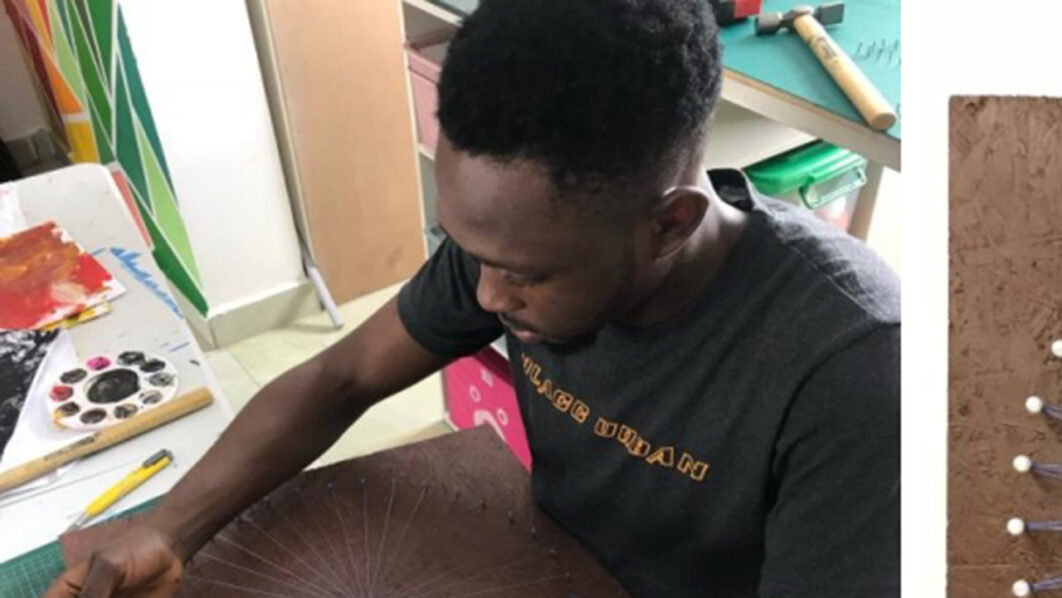
With a Bachelors degree in Architecture from the University of Jos and a master’s degree in Industrial Design, University of the Arts, London Central, Saint Martins; Wakrot Chinshaka is redefining the arts space. He is one of the people you can regard as a renaissance artist: The term Renaissance man or polymath is used for a very clever man who is good at many different things — He is a true Renaissance whose creative journey seamlessly bridges architecture, industrial design, and fine art.
Chinshaka’s artistic foundation is anchored in his background in architecture and industrial design. These have equipped him “with a unique ability to balance functionality and aesthetic appeal,” he says, fueling his “exploration of art as a medium for solving real-world problems.”
He adds, “my goal is to draw attention to the critical importance of peace, understanding, and unity in our communities. I hope these artworks encourage others to take a stand against the violence that has become all too prevalent.”
His multidisciplinary perspective enriches his creative process, allowing him to infuse elements of structure, design, and storytelling into his work.
With a deep-rooted passion for addressing societal and human challenges, Chinshaka’s confronts the norm with solutions. This backdrop inspires much of his work, including acclaimed projects such as More Love, Less War and The Blood-Stained Child, which address pressing social and cultural issues.
Through these initiatives, Chinshaka uses art as a vehicle for fostering unity, celebrating diversity, and advocating for peace in his homeland and beyond. He crafts work that transcend traditional boundaries, spanning digital art, acrylic on canvas, string art, and fabric pattern design, showcasing his versatility and boundless creativity. In his The Blood-Stained Child, a digital art series, he confronts the social norms in Nigeria, which include violence and unrest among other issues that have deeply affected Nigeria, particularly in the Northern and Middle Belt regions where Chinshaka grew up. His themes spark dialogue on violence and unity.
Through this series, Chinshaka seeks to raise awareness and spark dialogue about the urgent need for peace and unity in Nigeria and across the world, using art as a catalyst for social change. “Art has the unique ability to move people and inspire action,” says Chinshaka.
The series features four distinct artworks, each carrying a profound message: “Timeless Beauty,”
This piece celebrates the natural beauty of women, highlighting how minimal adornment can emphasise their inherent elegance, regardless of race, colour, or body structure.
The Blood-Stained Child is more than an art series — it is a call to action. It urges viewers to confront the violence that has scarred communities and to work towards a future where peace and unity are the norm. It is a collection of artworks that vividly reflect the crises, ethnic conflicts, and terrorism that have caused widespread suffering and loss of life in Nigeria. Each piece in the series is marked by the striking use of red, symbolising the bloodshed and the lives lost to these tragic events.
His Timeless Beauty is a tribute to women worldwide, honouring their enduring and universal grace while Cultural Tapestry showcases the rich cultural diversity of Nigeria through an array of patterns representing the country’s various ethnic groups. These patterns come together in a harmonious blend, symbolising the possibility of unity in diversity, creating a cohesive and beautiful design and more especially, Ancient Echoes, that is inspired by the ancient NOK art of Kaduna State, Nigeria—one of Africa’s oldest art forms—this piece pays homage to the deep historical roots of Nigerian culture.
Ancient Echoes connects the past with the present, underscoring the lasting significance of Nigeria’s artistic heritage and Unity in Diversity, which draws on a traditional Nigerian saying, “If you cook a pot of food for a community, the community will finish the pot of food, but if a whole community cooks for you, you’ll have a hard time finishing it,” to highlight the strength of collective effort.
“I am passionate about using art and design to address complex social issues in my country, across Africa and the world. I also believe in the transformative power of creativity and I strive to create products and experiences that inspire positive change,” he says.
His More Love, Less War is a breathtaking celebration of the intersection of tradition and modernity. The project centres on using rich colours and symbols from the designer’s hometown of Jos, Nigeria, to promote peace in the city that has been plagued by over 20 years of ethno-religious conflicts between groups.
This project uses the different unique fashion styles, colours and cultural patterns of the ethnic and religious groups in Jos to come up with a design using soft materials that incorporates all the styles, colours and patterns of the indigenous and settler tribes in Jos into one product that represents the entire Jos ethnicity. This design is aimed at building a strong campaign to end the ethno-religious conflict in Jos.
Starting with this project and looking to the future, the use of this design as a tool for pushing nonviolent campaigns in Jos is very necessary. The campaign together with the radical participatory design model will be a very solid tool to achieve this success.
A defining element of Chinshaka’s artistic portfolio is his mastery of string art, a medium he delved into during his tenure as Art Director at HOP Craft Studio in Abuja, Nigeria. This intricate art form, which involves weaving colorful threads around nails to create geometric and figurative designs, has become a hallmark of his creativity.
String art or pin and thread art, is characterized by an arrangement of coloured thread strung between points to form geometric patterns or representational designs such as a ship’s sails, sometimes with other artist material comprising the remainder of the work. Thread, wire, or string is wound around a grid of nails hammered into a velvet-covered wooden board. Though straight lines are formed by the string, the slightly different angles and metric positions at which strings intersect gives the appearance of Bézier curves (as in the mathematical concept of envelope of a family of straight lines). Quadratic Bézier curve are obtained from strings based on two intersecting segments. Other forms of string art include Spirelli, which is used for cardmaking and scrapbooking, and curve stitching, in which string is stitched through holes.
Chinshaka’s string art pieces stand out for their meticulous craftsmanship and the captivating narratives they convey. His work has been widely sought after, with numerous commissions from private collectors and corporate clients, further establishing him as a leading figure in this unique medium.






